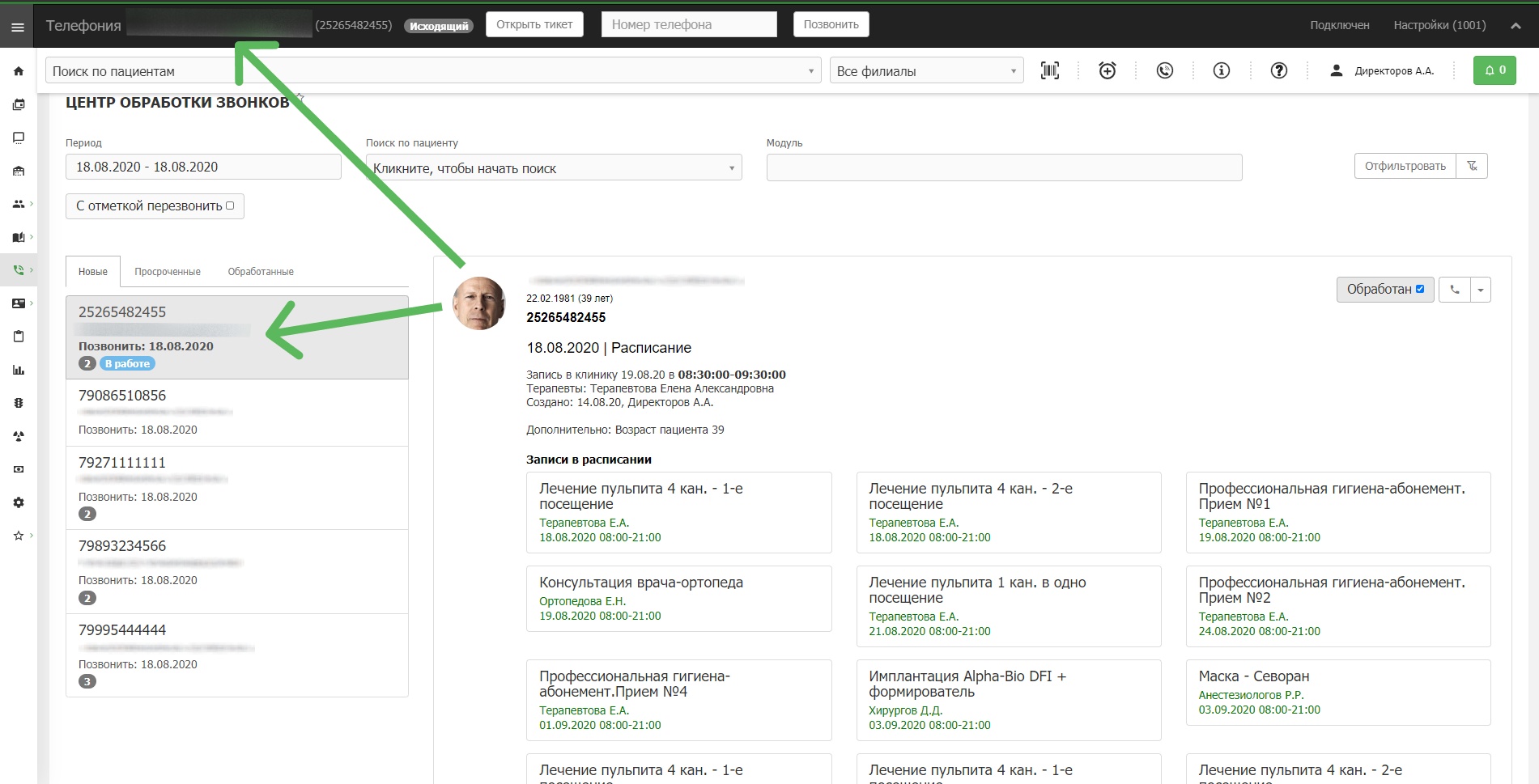
schedule it for the first appointment (this is the most expected action from an unidentified patient): We can immediately indicate the status: VIP, VHI. We can make an appointment with one doctor or several for a comprehensive examination. Then he sequentially (professional examination) or in parallel (therapist + surgeon, for example) will be examined. Here is the entry. This is the doctor's choice:
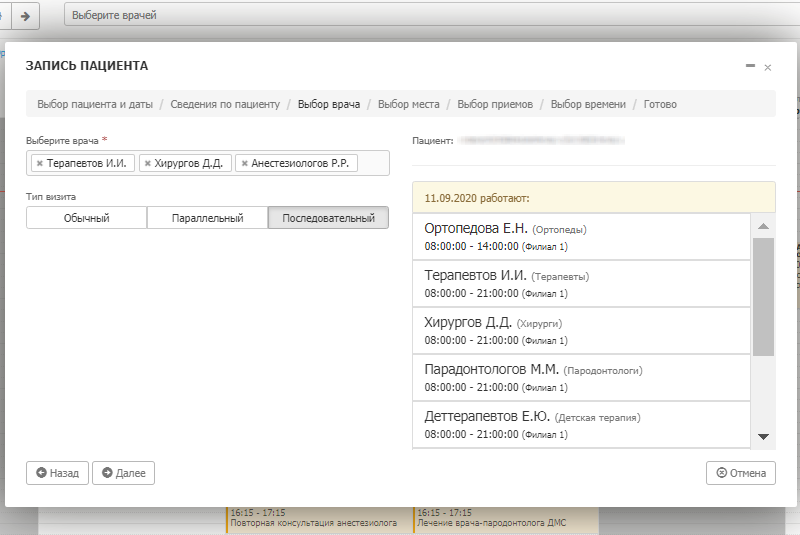
Appointment - initial consultation. You can't do without it.
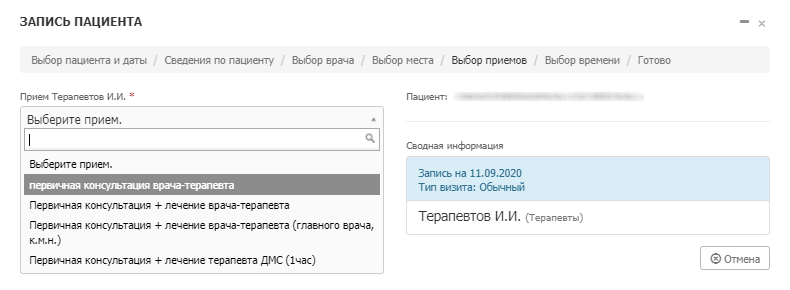
We can change the color of the recording and the duration of the reception. By default, the main color and duration for the service are always set. But, if the case is difficult or the patient is special, you can highlight this in the schedule. If the patient is repeated, then there will be appointments from the treatment plan.
That's it, at this stage the recording is over. Now we are waiting for the patient to come to the clinic.
Possible losses at this stage
- Calling a new patient should lead either to an appointment for an initial diagnosis or to a refusal. It is impossible to treat patients without diagnosis, because it is simply unacceptable according to the standard, firstly, and creates a sea of abuse, and secondly. Nevertheless, it is possible to immediately register the patient for diagnosis and treatment according to his most probable diagnosis.
- , (, ), , , , .
- , — , , . , «», , . , 15 . , .
- . , . .
,
We have sliders to design a visit. These are barcodes. They are glued or printed in the printing center on a plastic card and assigned to the patient for each visit. It is not necessary to do this, you can simply take into account patients by last name, and this is also in the functionality. But the slider system is very time-saving for the doctor and protects the owner from abuse in the clinic.

If the patient is a primary patient, then before admitting him, we suggest filling out a questionnaire. It allows you to protect yourself, and this is the recommendation of a lawyer. It contains information about drug allergies, blood pressure, etc. If the patient has any problems, the doctor at the appointment will receive a pop-up warning.
The questionnaire can be filled out through a connected tablet or through the section "Patient Information" - there, according to the patient's words, the administrator fills out. If you have your own profile template, you can download it at the stage of implementation. If not, then one of the typical ones is used. In general, we quite often bring automation to the clinic.
How it happens in the tablet:

Next, we read the QR code on the tablet, which is on the administrator's desk.
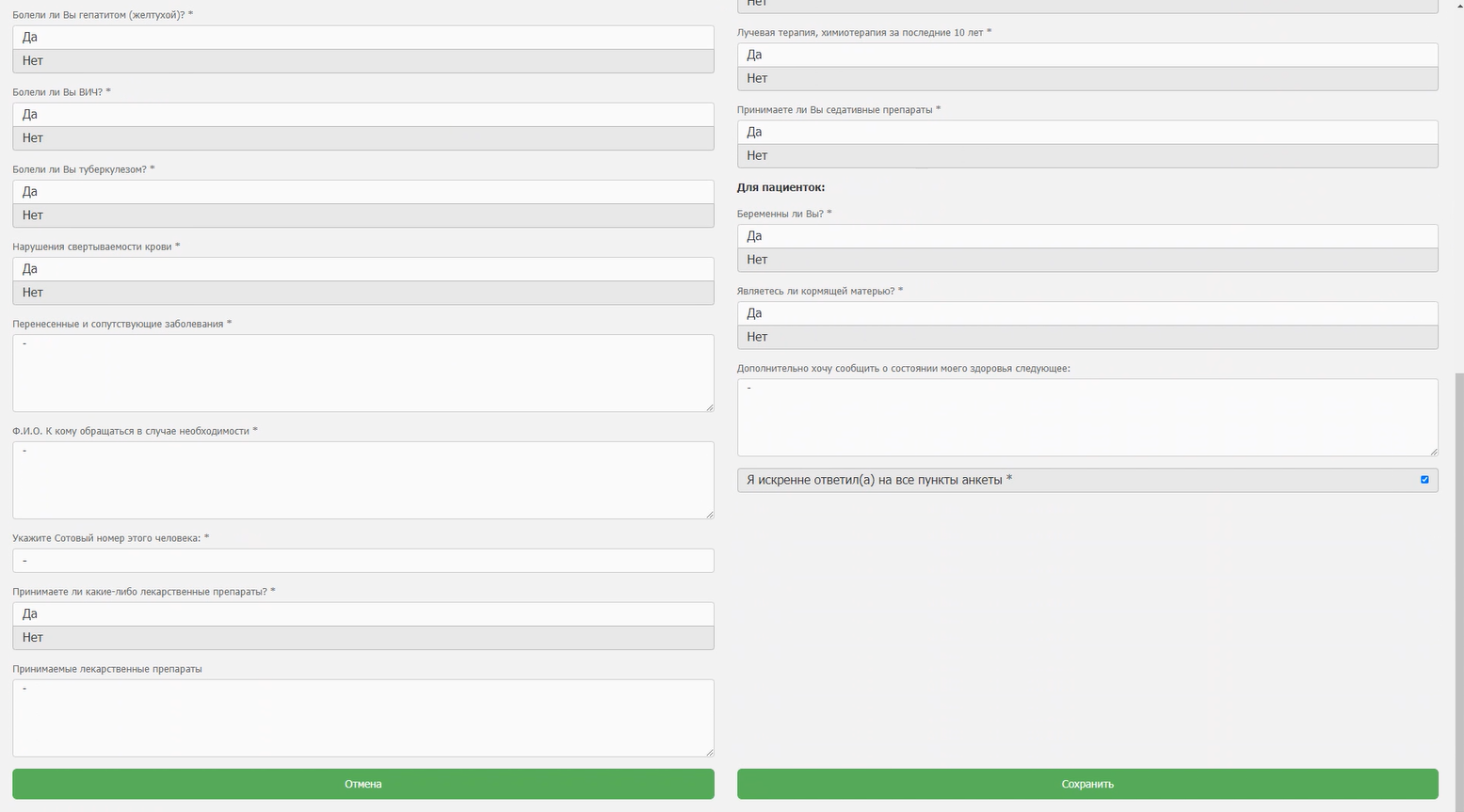
The patient gives the questionnaire to the administrator. The system reflects the information that the questionnaire is completed: The

questionnaire must be sent to print and signed:

Next, the patient's registration. Here's an adult:
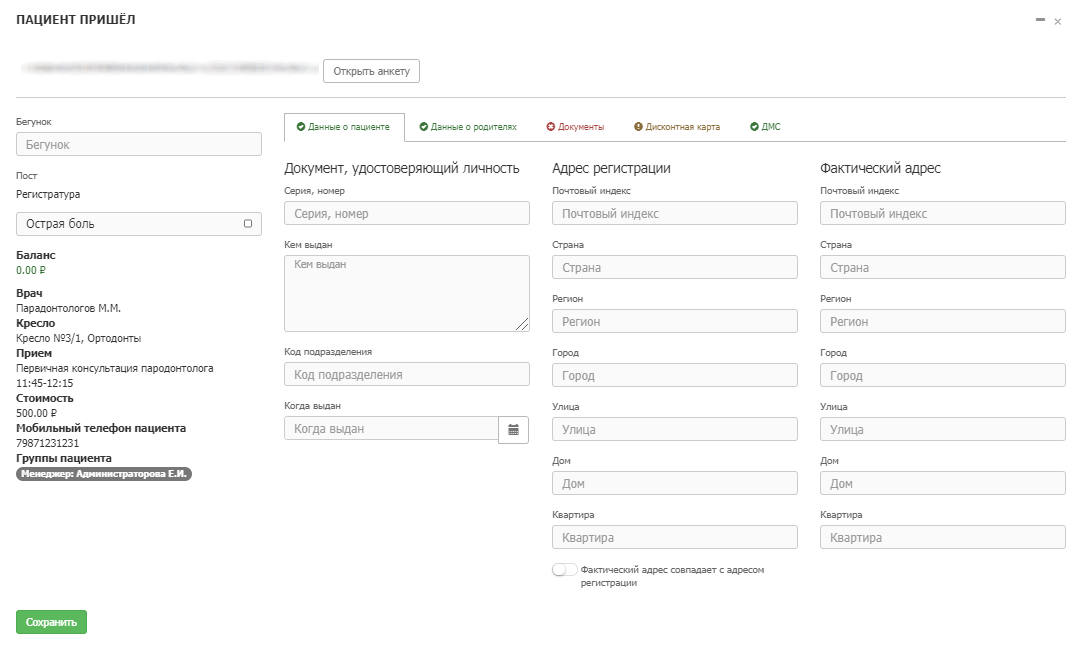
If the patient is under 18, the patient appears as a child, and a parent information field appears.

Agreement, notifications of non-compliance with recommendations, consent to the provision of medical services and the processing of personal data.
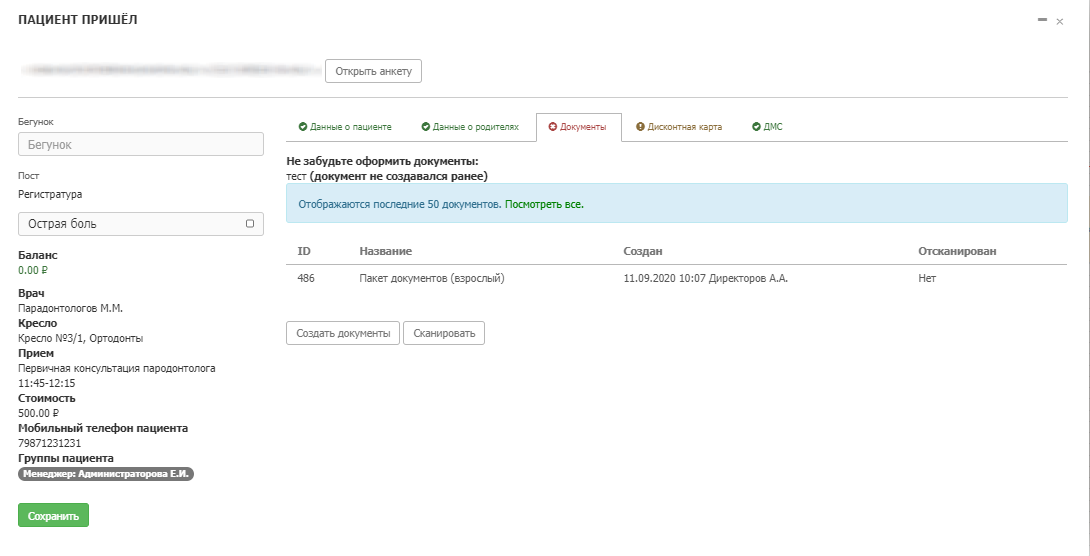
Each document is assigned a barcode, it can be scanned and verified that the documents are actually printed. At this stage, you can issue a discount card and attach documents from the insurance company.
If the patient has acute pain, then you can mark it, then the system will skip this step and will allow you to start seeing a doctor ahead of schedule.
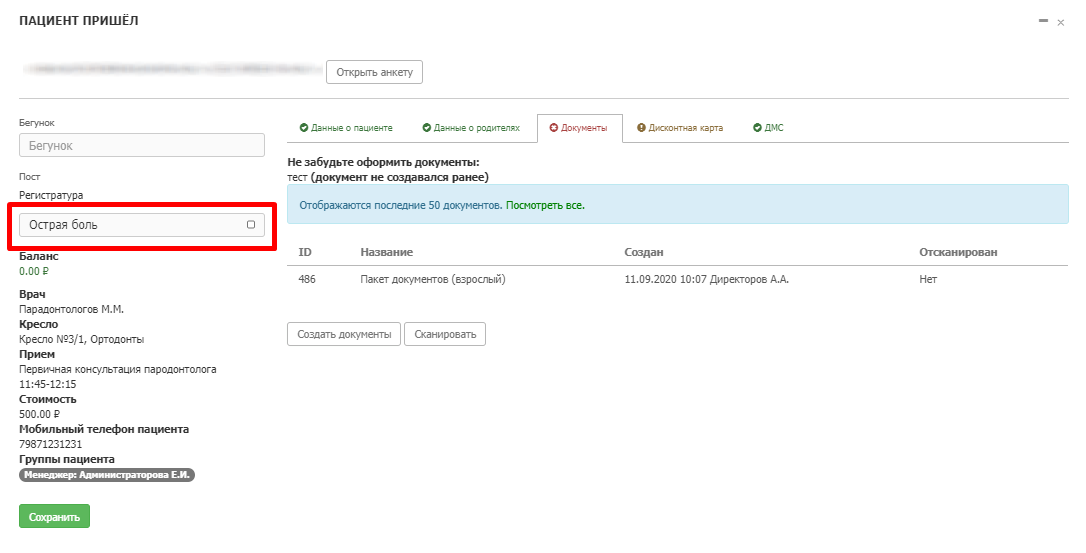
What losses are possible at this stage
- . «» . , , . , . , , , , . . , .
- , : , . , , ( 14 % ) , . : , , . , . : « , , , , . — ». . . . — . , , , .
Patient at the doctor
An assistant brings papers or a slider from the registry:
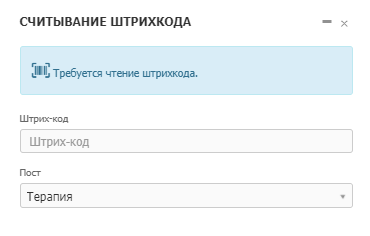
If it is worth "showing the questionnaire" by default, the doctor's questionnaire will immediately pop up.
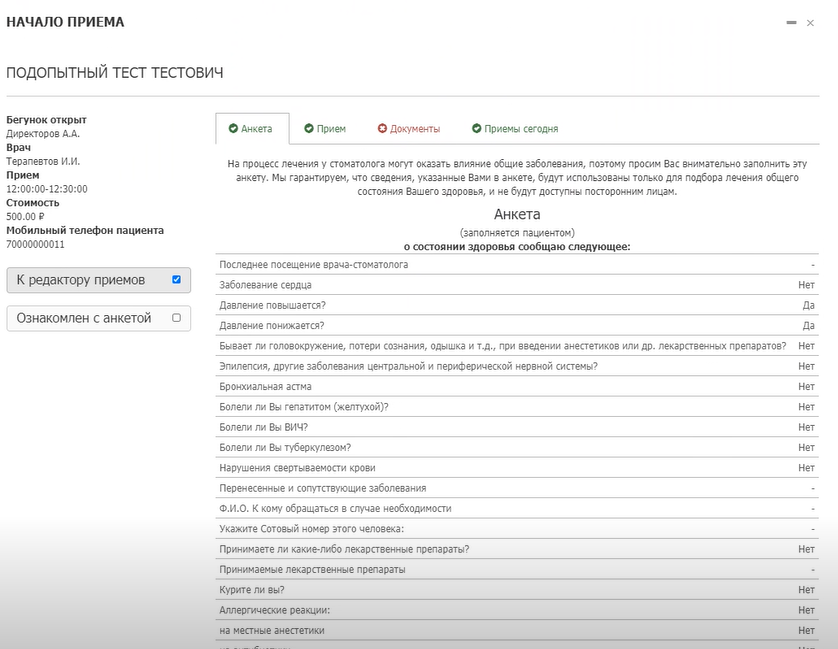
The doctor can change the time of appointment and its description, if the administrator made a mistake and recorded it not for a scheduled appointment, but for treatment.

Here you need to check the documents and add your own: an additional agreement with a description and cost of admission, consent to the intervention, refusal of types of medical interventions.

View other patient's appointments today:
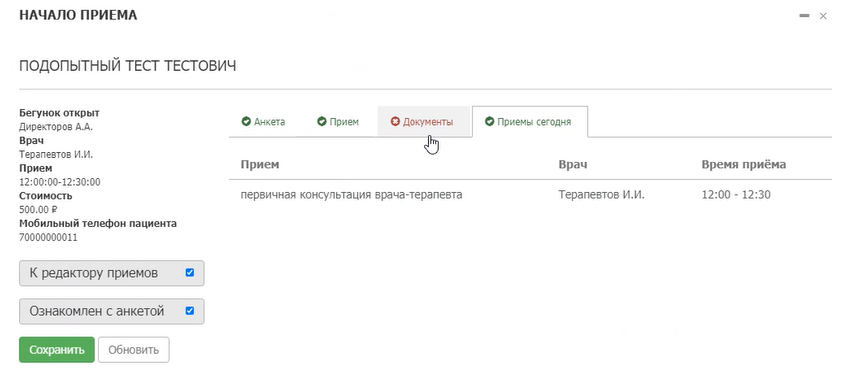
If the patient has health problems, a pop-up window appears:

Next, in fact, you can start the appointment. If the patient has a picture, it will be shown immediately. The doctor's first task is to note problems in the dental formula.
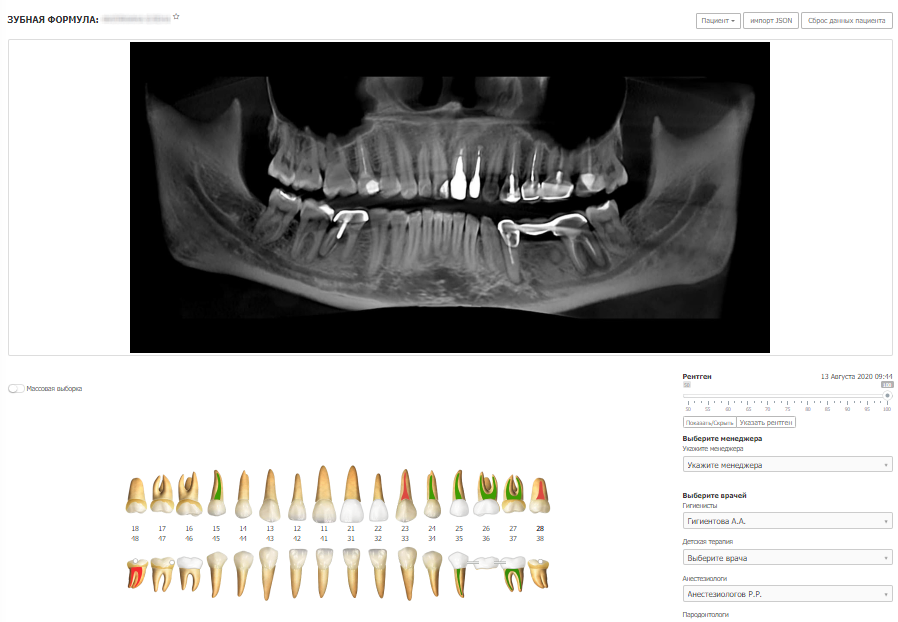
At the top, problems are indicated, at the bottom, solutions:

Depending on the part of the tooth that the dentist presses on, the system suggests corresponding problems.


There is a massive sample in case of problems of the entire oral cavity.

The patient's problem will be reflected in the dental formula.

The solutions will pull up several options to choose from.

Problem - solution:

If a different department is involved in decisions, it is imperative to choose a doctor so that the treatment plan is preserved. This is necessary so that a treatment plan is created and appointments are made. The doctor can then be replaced.
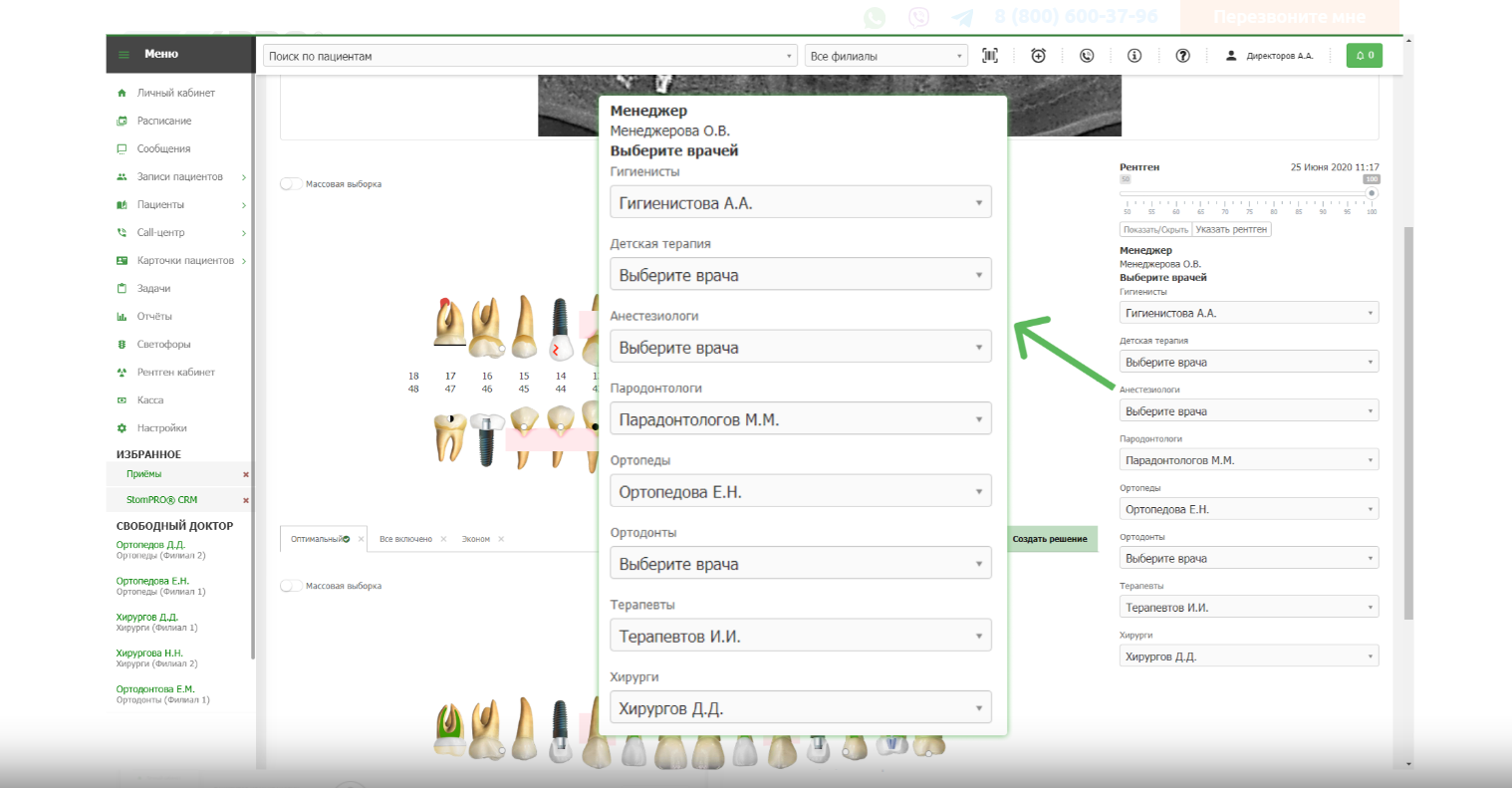
You can create as many plans as you like. You can create a new one, you can copy this one. Creation of multiple plans allows the patient to create several visual plans with different costs and facilitate the choice. It takes about a minute to create three treatment plans. Usually, the doctor will do the exam and the assistant will fill in the dental formula.
Losses at this stage
- . , , . 99 % : - , - , - , , - . — , . , - — . .
- . — . — . , - ( , -). , - . .
Appointments and receipts for them are formed on the basis of treatment plans.
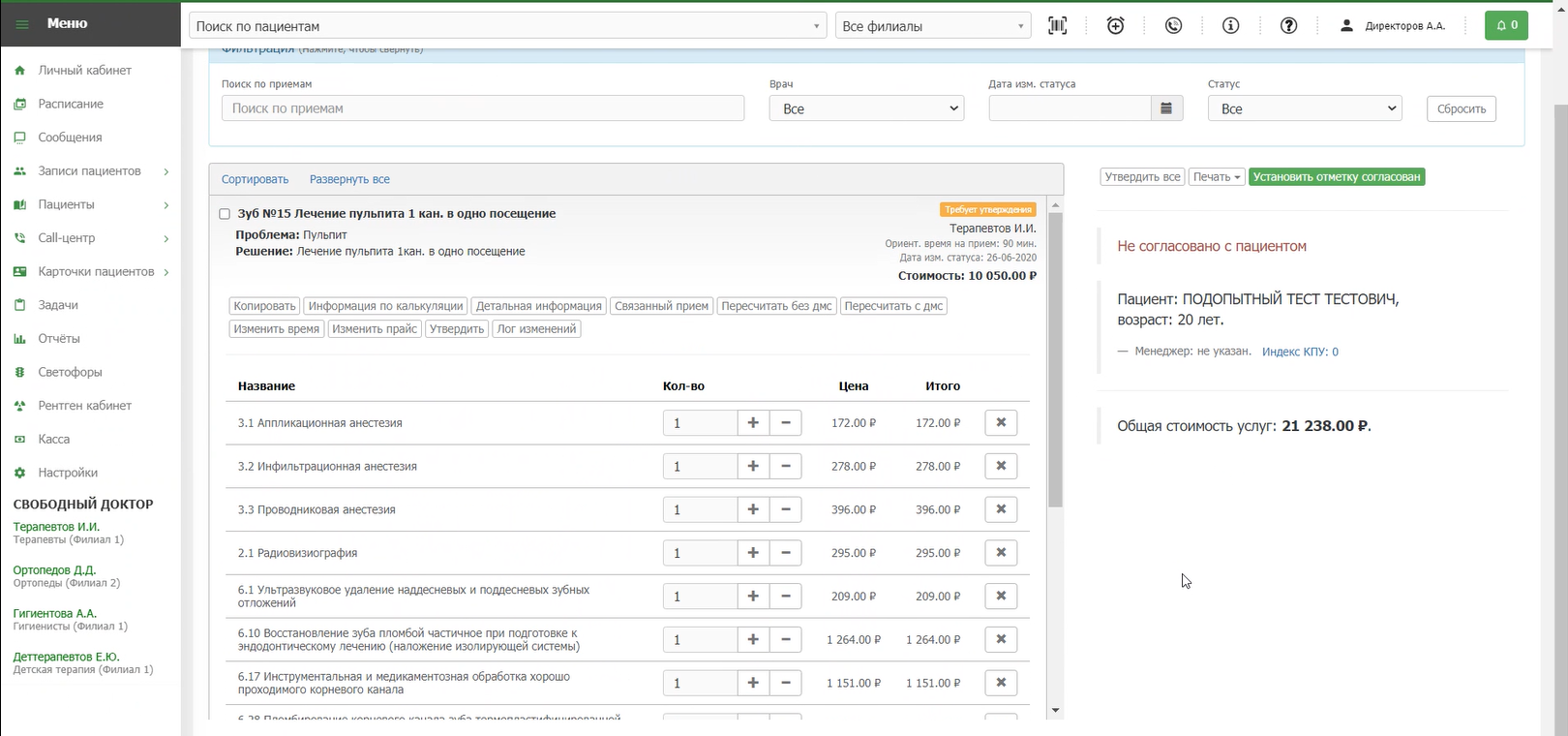
Services added to a reception can be deleted. You can add related services that will be offered to the appointment (anesthesia, treatment, etc.). The lists are agreed upon during the implementation phase.

The cost of admission is adjusted automatically. You can note the type of price: VHI, doctor's category or additional consultations from specialists.

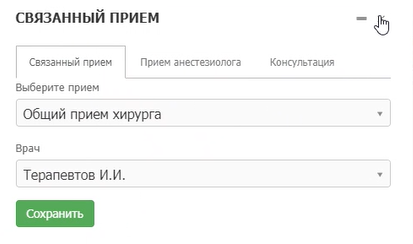
The treatment plan can be printed out with or without prices:
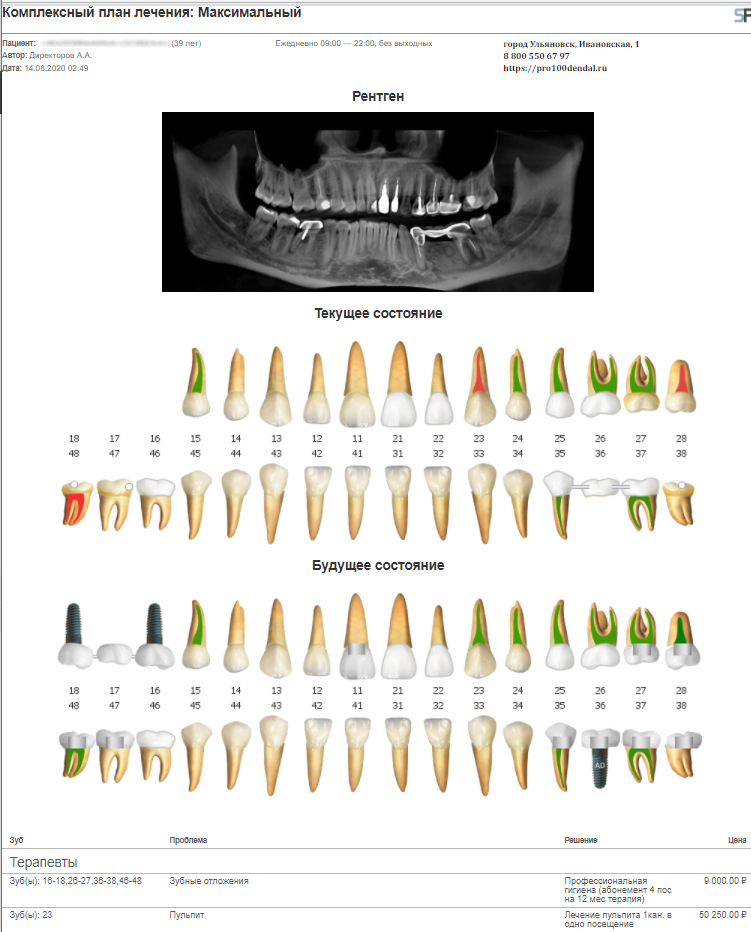

When a treatment plan is agreed with the patient, the corresponding indicator appears:

All created plans are reflected in the manager and the head physician.
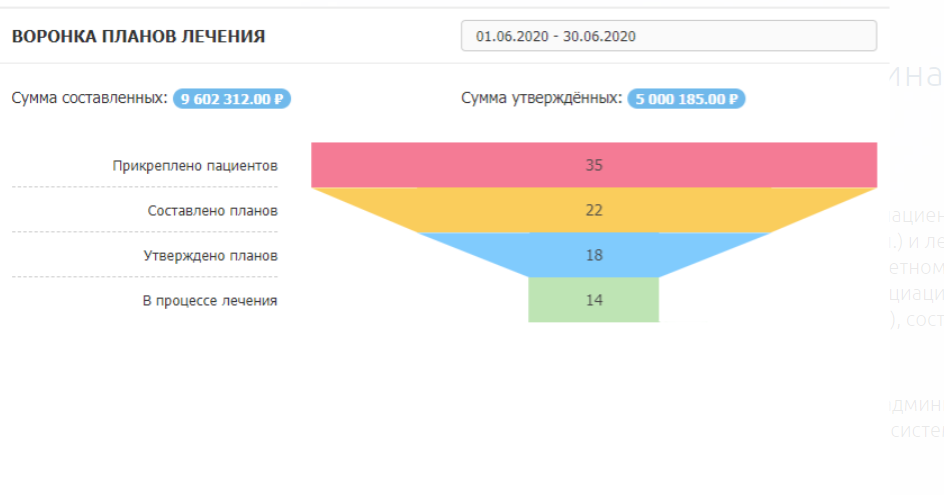
Techniques can be combined
Approve within each service and all together:

Once agreed, the techniques can be used in the schedule. If you mark them in the record, the administrator will receive a notification:

Losses at this stage
- Some doctors cannot or do not want to talk about money. About a third of doctors are ashamed of this process, and about a third simply explain less effectively than an administrator. The problem is that without such a detailed treatment plan, the administrator simply won't know what is being done to the patient and why. With a plan - he will be able to conduct a dialogue. During this dialogue, the administrator explains to the patient all the features of the plan. As a result, it turns out that the doctor only heals, and the administrator sells.
- , , « » , . , . , «» , . , . 5 % ? . , : . . , , , - .
- , . . , - , - , . : , «», - . , . , , . - , . .
The strangest case was after a patient who made very customized procedures for about 5 million rubles. She specially came to us from Austria, and we optimized her stay in the clinic so as to do everything she needed for a minimum of appointments. So, at the end of the last appointment, she put about 90 thousand rubles of tip right into the doctor's pocket. The doctor immediately informed the owner of the clinic and asked what to do with the money. Naturally leave. But if he left the money for himself in silence, and then someone found out, suspicions of theft might arise. Because our people don't leave such tips.
Closing the appointment
Scanning the slider:

The appointment completion window opens:
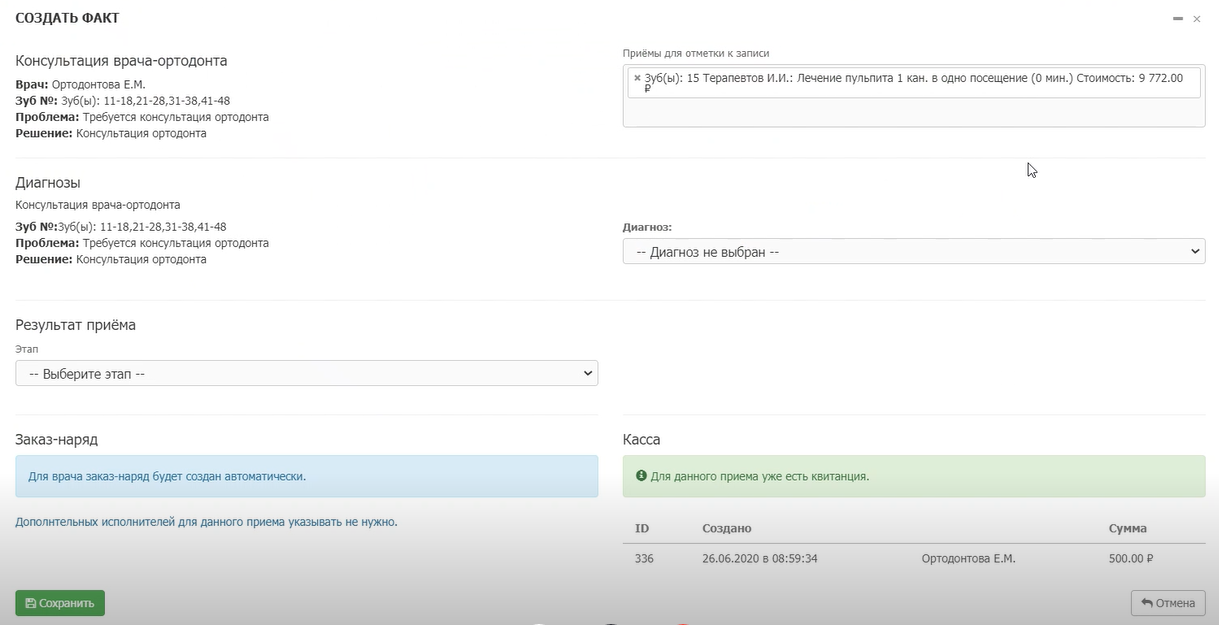
At this stage, we put down the diagnosis and the results of the appointment, as well as the "Caring Doctor" code, which will remind you when to call the patient and what he needs to say in order to facilitate the work of the call center:
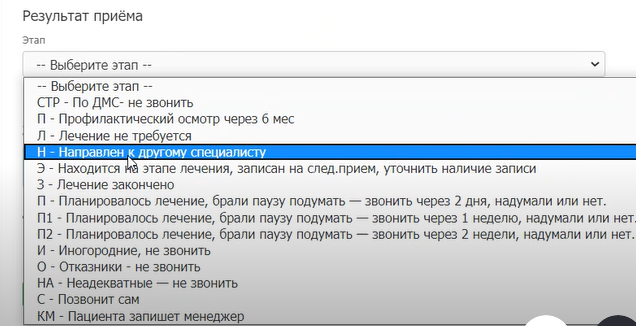

Appointment completed:

Task created for the call center: You

can close the appointment and send the patient for payment by filling out the card later. You can fill out the card with the patient.
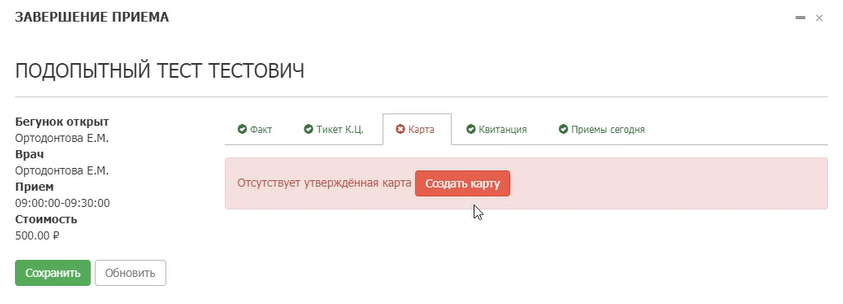
The cards depend on doctors.
Here are the orthodontists:


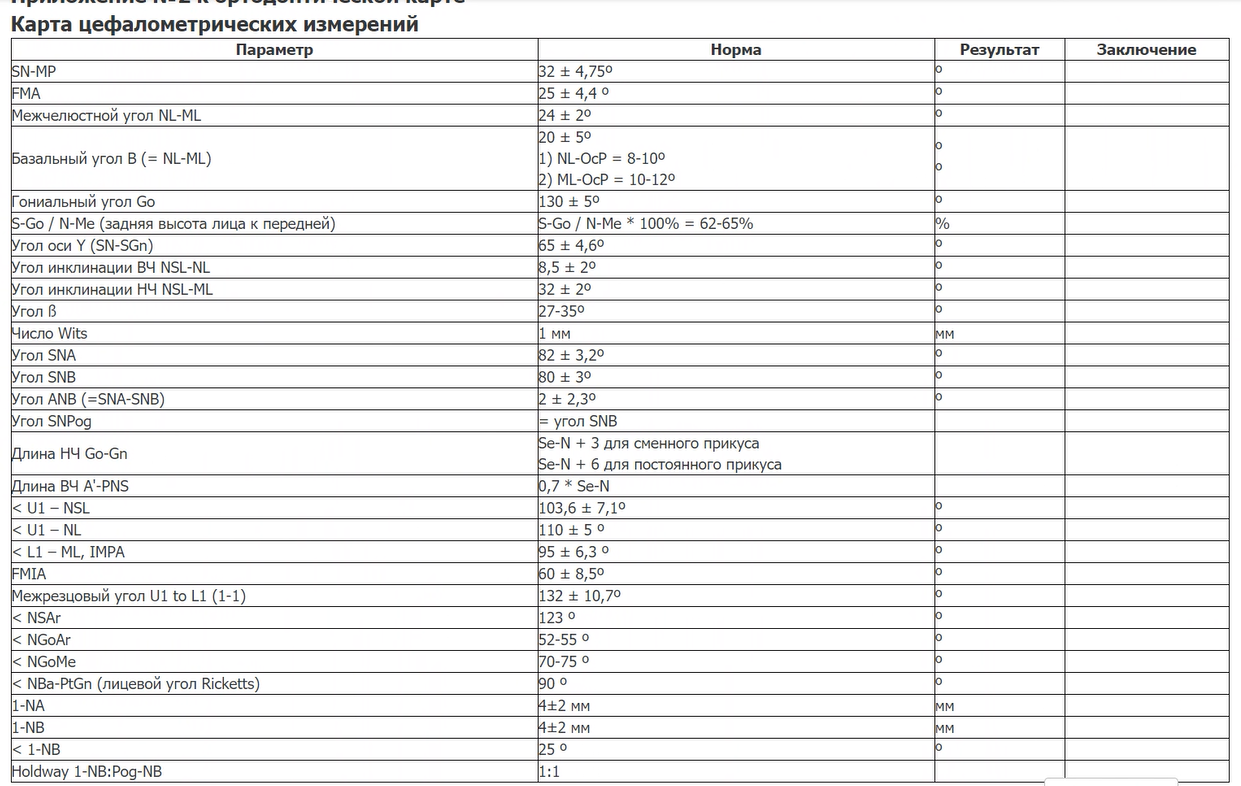
The orthodontist card fills out in about five to ten minutes.
The cards of all doctors except for orthodontists are filled in in two minutes using tags and voice dialing:
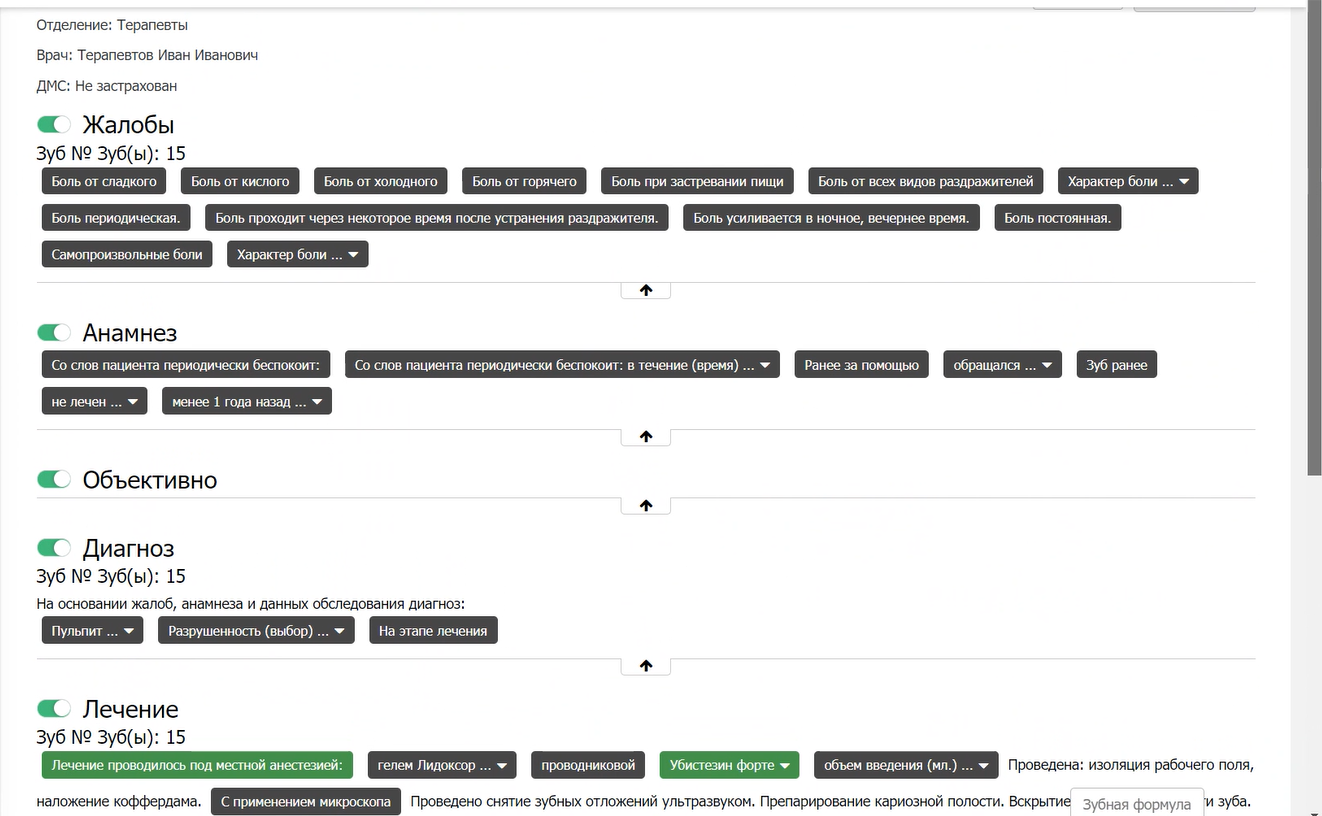
There are common tags - "pain from sour" - and drop-down lists: "tooth was previously treated / caries treated / not treated":

Marking complaints in tags
After that, we translate it into text format and quickly modify the map using voice dialing and editing mode.
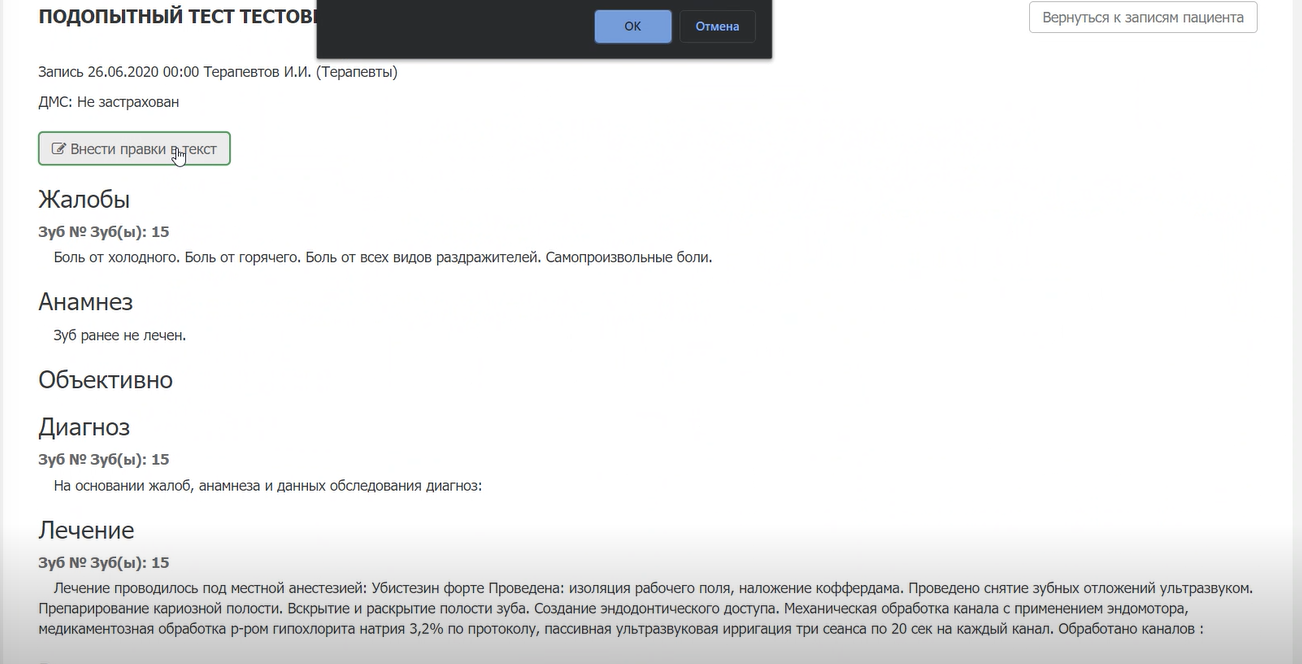
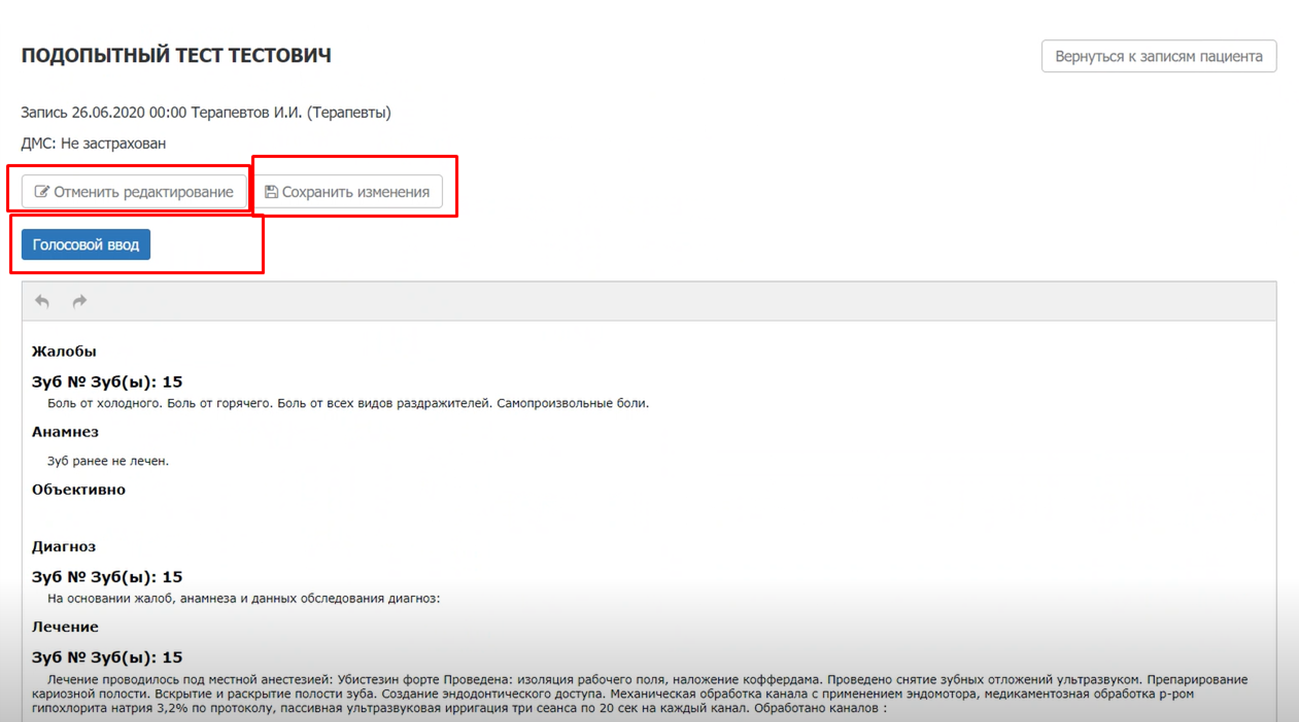
The head physician and other persons responsible for checking the cards have verification buttons.


Losses at this stage
- If undocumented procedures occur, there is a chance of theft. The procedure for changing the card should be very quick and pleasant. All CRM is a help to the doctor, not an obstacle. Alas, many do not understand this and build terrible interfaces. The same 1C creations that we tried to use in the clinic greatly interfere with the reception.
- ! , -, - . , , «-» , . , . .
- . , . , . . . , , , -, .

The ruble icon in the schedule means that the appointment has been created but not paid. When the patient comes to the checkout, we scan his card:

We see that the receipt has not been paid:
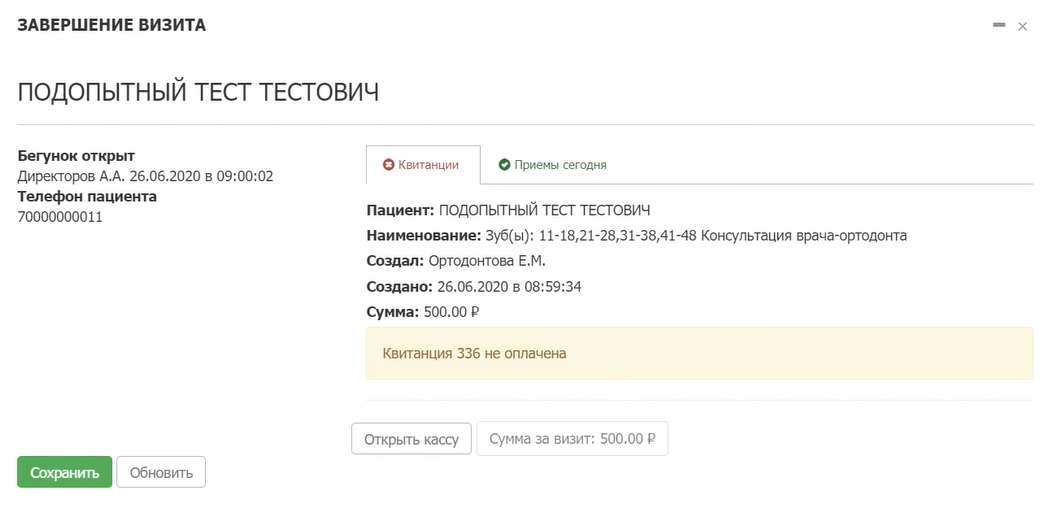
Open the checkout, click to pay:
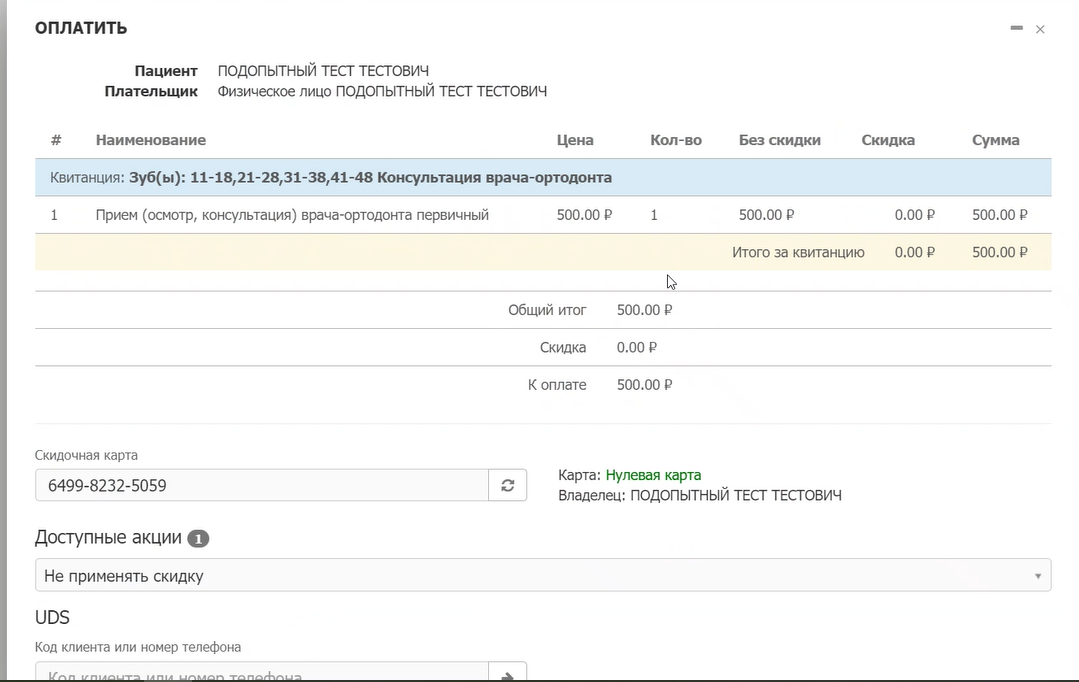
We can write off the entire amount from the card, or write off a part from the card, take part in cash, etc.:

Once again we scan the slider.

And we finish the visit: The

slider is untied automatically.
Then we see the reports:
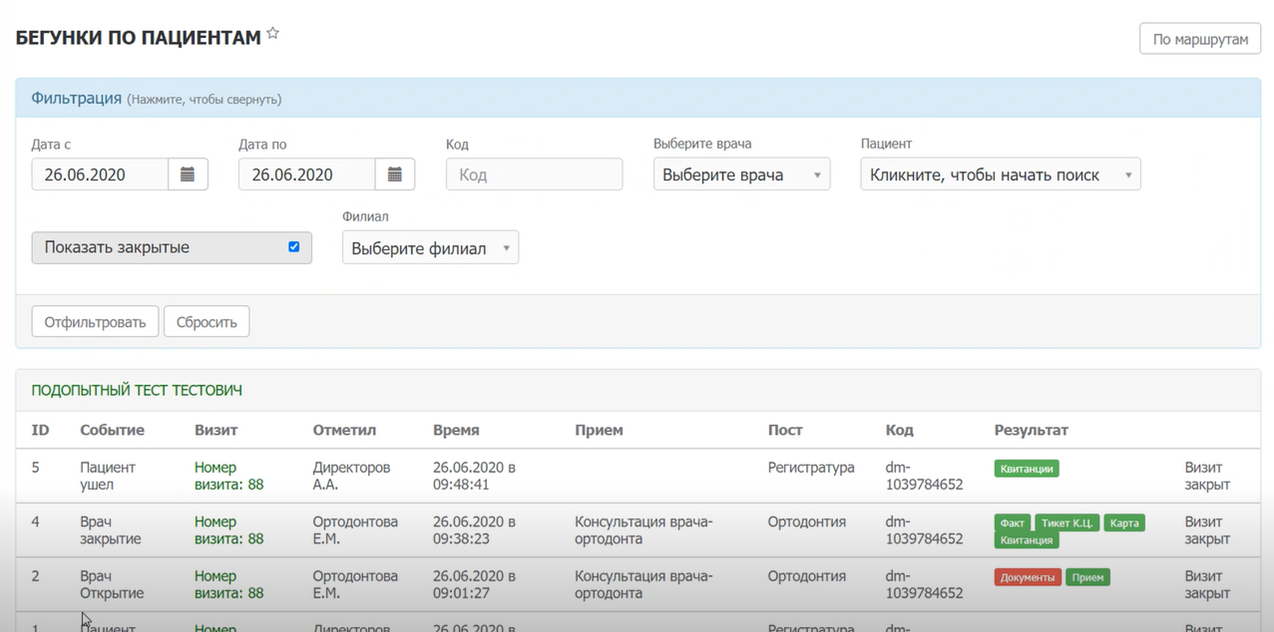
Here, for example, documents are highlighted in red. This means that not all documents from the mandatory package are printed and signed with the patient.
Then you can book the patient for the next appointment. Open the scheduled ones:

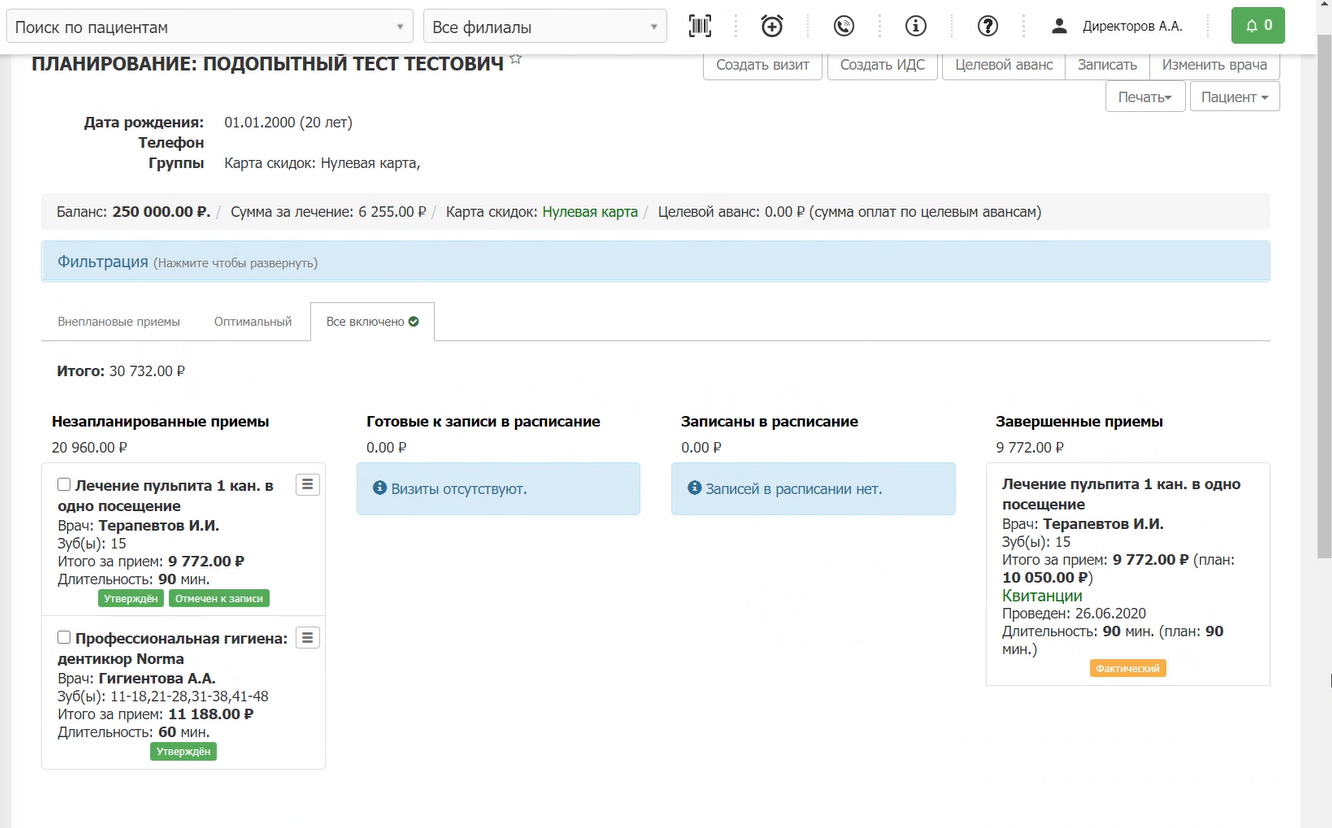
Just drag the appointment from the “Unplanned” column to the “Ready for schedule”:
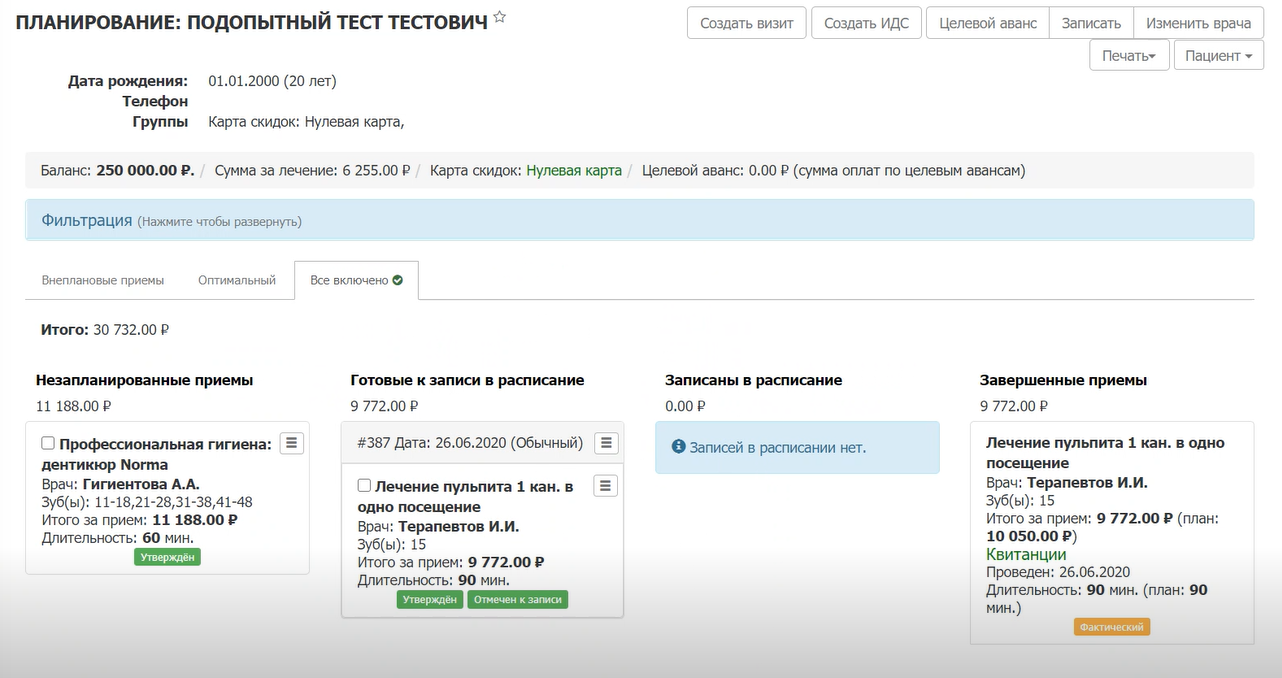
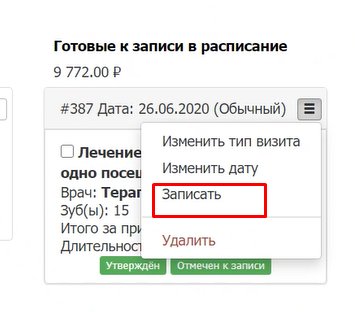
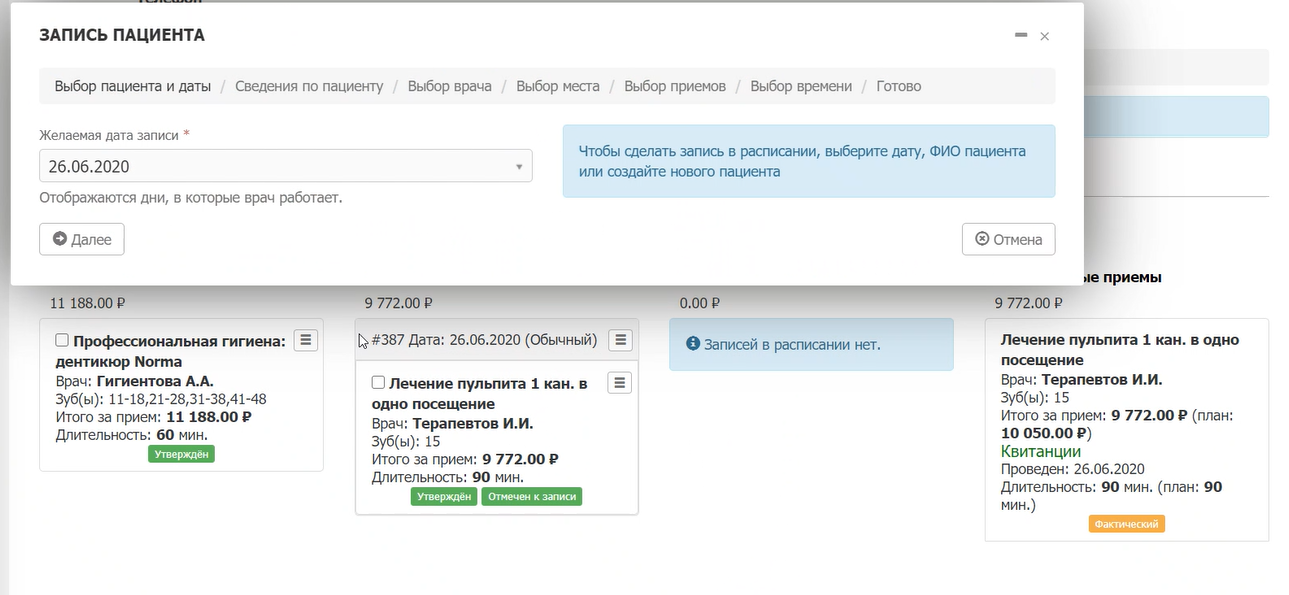

Done! The appointment is recorded in the schedule.

In the schedule, the administrator will see appointments by doctors, chairs, patient:
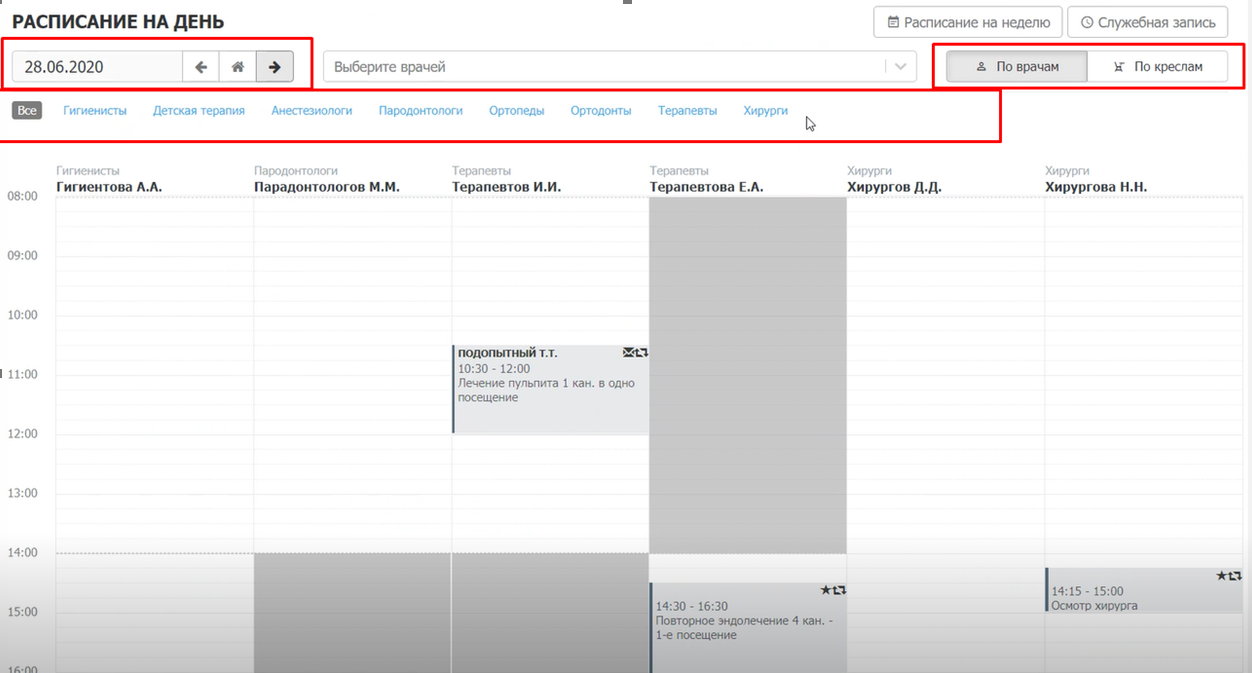
Also, tasks for the administrator have been created for each doctor: call and clarify the patient's condition. The system will calculate the dates itself and remind all participants.
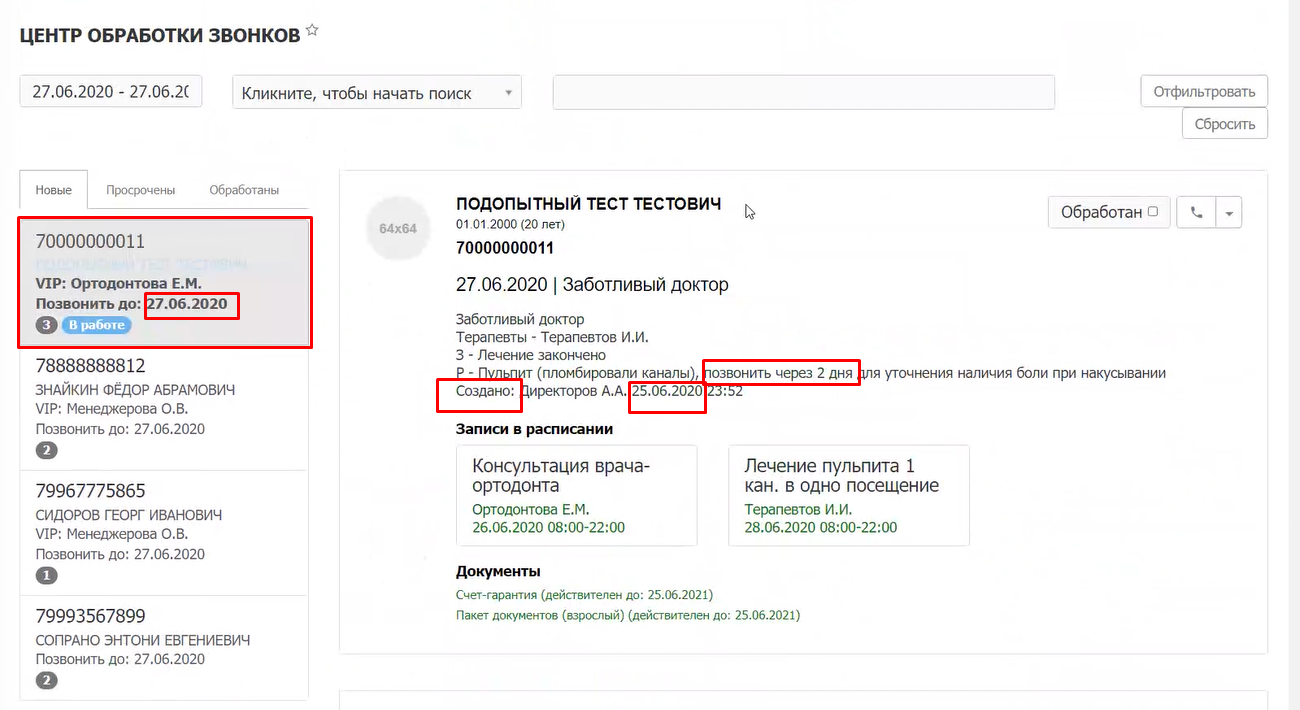
Call processing:
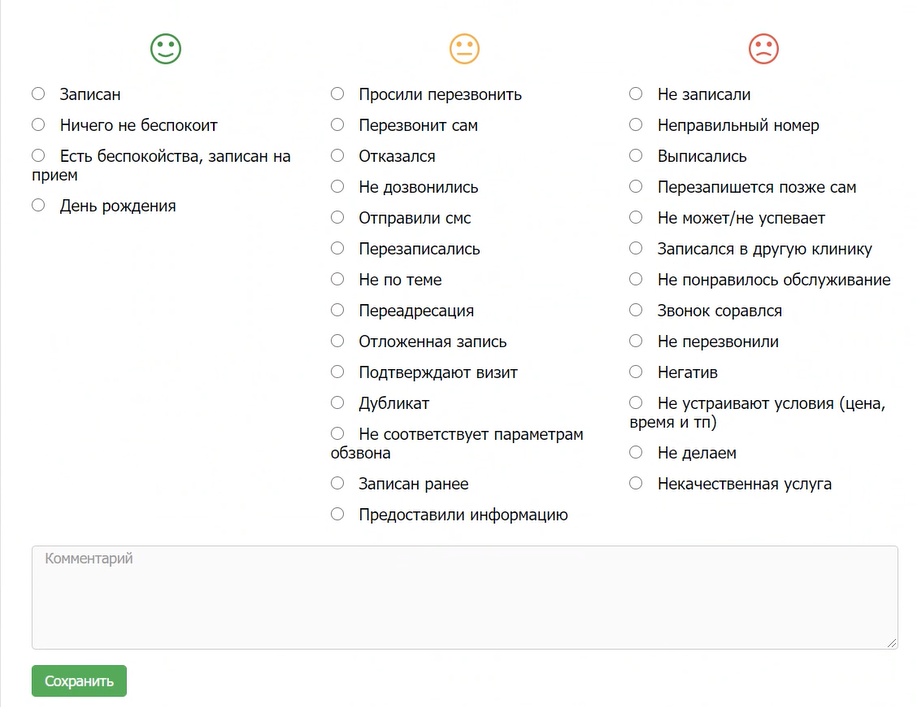
If the patient did not get through or he asked to call back, mark the required item:


Losses at this stage
- The patient should not be “suspended” - he should always have the next appointment scheduled. If everything is over - hygiene after six months or a preventive visit after N years. If not, the next scheduled appointment.
- . : . , , . - ( ), - .
- : «». , , , - . .
- There are losses on discounts: if the doctor or assistant is late for the start of the working day, and the patient arrives on time, then he will be given a discount. It is necessary to consider the time of arrival of each.
The anti-theft system works together with an assistant and does not interfere with the reception and the process in general. "Anti-theft" is responsible for ensuring that there are no leftist tricks. The assistant helps to do everything quickly and removes the human factor. As a result, it is checked so that the plan and fact coincide, or all changes are clearly justified.
It's not all loss
These are not all losses, and far from all the processes of the clinic. But, I hope, I managed to convey a rough idea. In general, I can say that if a clinic at the TTK in Moscow has 800 thousand rubles in revenue per month, this is very strange. The normal figure is about 1.5 million per chair. If that's the case, it's time to either reduce losses, or think about the fact that someone has already bought a car on this difference.
PS More details can be found on our website here , and here is the webinar.